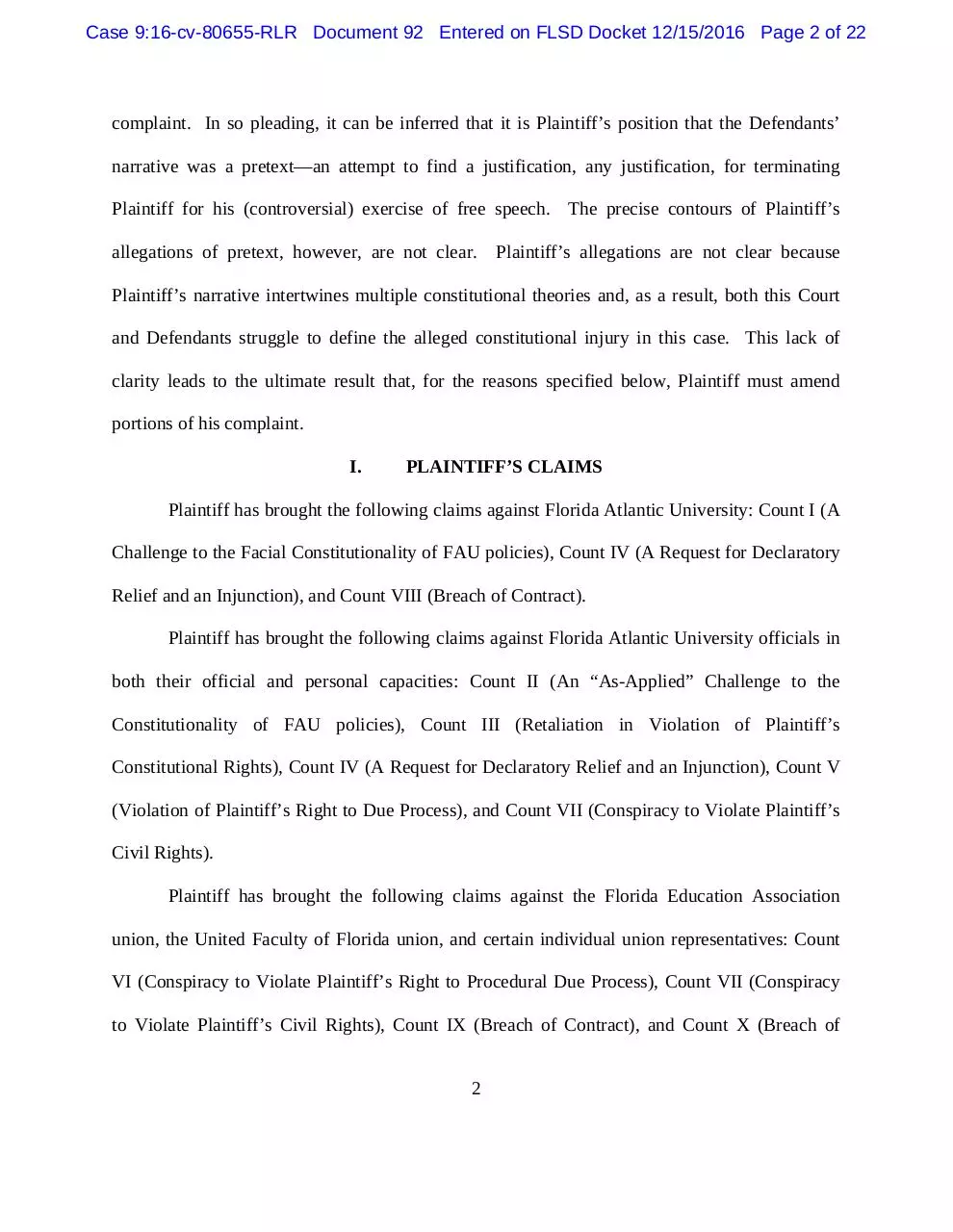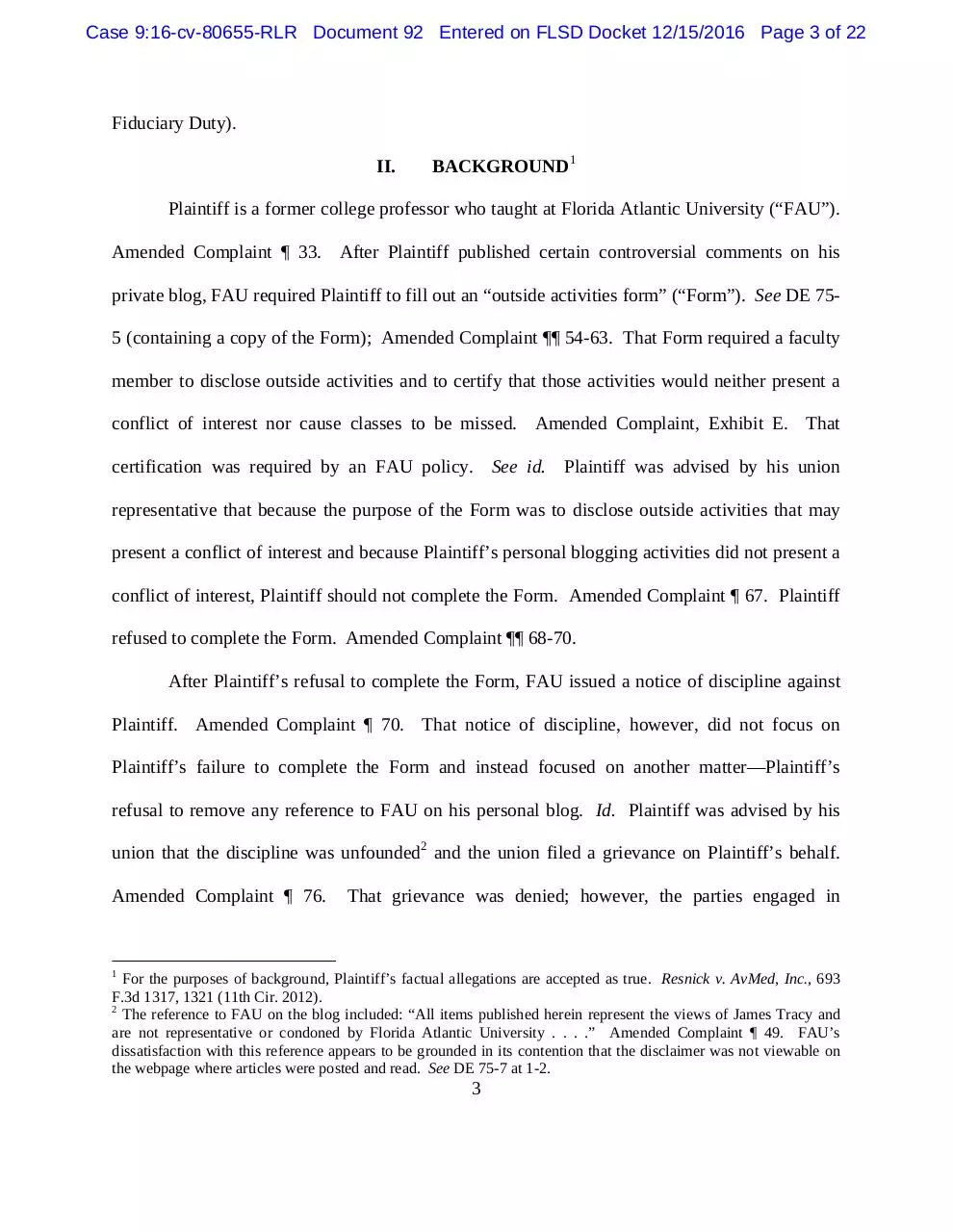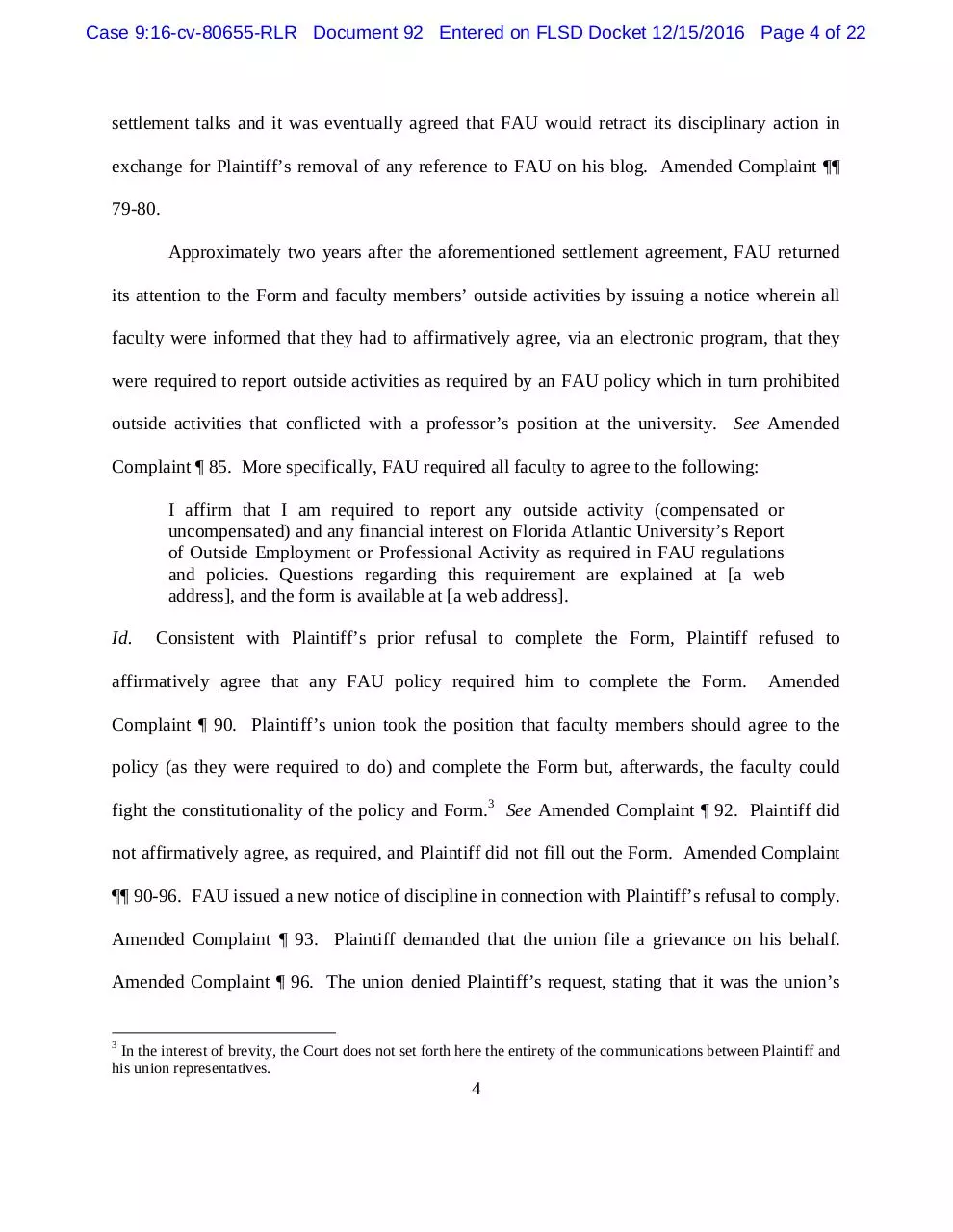dismissed (PDF)
File information
Title: Microsoft Word - 16-80655.Tracy.Dismiss.Qualified Imm and Union Pre-Emption v4
Author: BenjaminKennard
This PDF 1.5 document has been generated by PScript5.dll Version 5.2.2 / Acrobat Distiller 10.1.16 (Windows); modified using iText 2.1.7 by 1T3XT, and has been sent on pdf-archive.com on 16/12/2016 at 03:21, from IP address 24.7.x.x.
The current document download page has been viewed 555 times.
File size: 105.44 KB (22 pages).
Privacy: public file





File preview
Case 9:16-cv-80655-RLR Document 92 Entered on FLSD Docket 12/15/2016 Page 1 of 22
UNITED STATES DISTRICT COURT
SOUTHERN DISTRICT OF FLORIDA
CASE NO. 9:16-CV-80655-ROSENBERG/HOPKINS
JAMES TRACY,
Plaintiff,
v.
FLORIDA ATLANTIC UNIVERSITY
BOARD OF TRUSTEES a/k/a
FLORIDA ATLANTIC UNIVERSITY,
et al.,
Defendants.
__________________________________/
ORDER GRANTING IN PART AND DENYING
IN PART DEFENDANTS’ MOTION TO DISMISS
This cause is before the Court on Defendants’ Motion to Dismiss (“motion”) [DE 79].
The motion has been fully briefed and the Court heard oral argument on the motion on December
1, 2016. For the reasons set forth below, the motion is granted in part and denied in part.
This is a case about the First Amendment right to free speech. The setting for this case is
a college campus, which is certainly a familiar setting for First Amendment jurisprudence. The
story of this case is a story of two competing narratives. The first such narrative, brought by
Plaintiff, is that he, a professor, was terminated for exercising his right to free speech in a
personal, off-campus blog. The second narrative belongs to Defendants and, according to them,
Plaintiff was terminated for consistently and willfully refusing to comply with internal
administrative requirements. In the quintessential course of litigation, the Court would expect
these competing narratives to be offered by each side marshaling the evidence and arguments in
support of their respective positions. In this case, however, Plaintiff pleads both narratives in his
Case 9:16-cv-80655-RLR Document 92 Entered on FLSD Docket 12/15/2016 Page 2 of 22
complaint. In so pleading, it can be inferred that it is Plaintiff’s position that the Defendants’
narrative was a pretext—an attempt to find a justification, any justification, for terminating
Plaintiff for his (controversial) exercise of free speech. The precise contours of Plaintiff’s
allegations of pretext, however, are not clear. Plaintiff’s allegations are not clear because
Plaintiff’s narrative intertwines multiple constitutional theories and, as a result, both this Court
and Defendants struggle to define the alleged constitutional injury in this case. This lack of
clarity leads to the ultimate result that, for the reasons specified below, Plaintiff must amend
portions of his complaint.
I.
PLAINTIFF’S CLAIMS
Plaintiff has brought the following claims against Florida Atlantic University: Count I (A
Challenge to the Facial Constitutionality of FAU policies), Count IV (A Request for Declaratory
Relief and an Injunction), and Count VIII (Breach of Contract).
Plaintiff has brought the following claims against Florida Atlantic University officials in
both their official and personal capacities: Count II (An “As-Applied” Challenge to the
Constitutionality of FAU policies), Count III (Retaliation in Violation of Plaintiff’s
Constitutional Rights), Count IV (A Request for Declaratory Relief and an Injunction), Count V
(Violation of Plaintiff’s Right to Due Process), and Count VII (Conspiracy to Violate Plaintiff’s
Civil Rights).
Plaintiff has brought the following claims against the Florida Education Association
union, the United Faculty of Florida union, and certain individual union representatives: Count
VI (Conspiracy to Violate Plaintiff’s Right to Procedural Due Process), Count VII (Conspiracy
to Violate Plaintiff’s Civil Rights), Count IX (Breach of Contract), and Count X (Breach of
2
Case 9:16-cv-80655-RLR Document 92 Entered on FLSD Docket 12/15/2016 Page 3 of 22
Fiduciary Duty).
II.
BACKGROUND1
Plaintiff is a former college professor who taught at Florida Atlantic University (“FAU”).
Amended Complaint ¶ 33. After Plaintiff published certain controversial comments on his
private blog, FAU required Plaintiff to fill out an “outside activities form” (“Form”). See DE 755 (containing a copy of the Form); Amended Complaint ¶¶ 54-63. That Form required a faculty
member to disclose outside activities and to certify that those activities would neither present a
conflict of interest nor cause classes to be missed. Amended Complaint, Exhibit E. That
certification was required by an FAU policy. See id. Plaintiff was advised by his union
representative that because the purpose of the Form was to disclose outside activities that may
present a conflict of interest and because Plaintiff’s personal blogging activities did not present a
conflict of interest, Plaintiff should not complete the Form. Amended Complaint ¶ 67. Plaintiff
refused to complete the Form. Amended Complaint ¶¶ 68-70.
After Plaintiff’s refusal to complete the Form, FAU issued a notice of discipline against
Plaintiff. Amended Complaint ¶ 70. That notice of discipline, however, did not focus on
Plaintiff’s failure to complete the Form and instead focused on another matter—Plaintiff’s
refusal to remove any reference to FAU on his personal blog. Id. Plaintiff was advised by his
union that the discipline was unfounded2 and the union filed a grievance on Plaintiff’s behalf.
Amended Complaint ¶ 76.
That grievance was denied; however, the parties engaged in
1
For the purposes of background, Plaintiff’s factual allegations are accepted as true. Resnick v. AvMed, Inc., 693
F.3d 1317, 1321 (11th Cir. 2012).
2
The reference to FAU on the blog included: “All items published herein represent the views of James Tracy and
are not representative or condoned by Florida Atlantic University . . . .” Amended Complaint ¶ 49. FAU’s
dissatisfaction with this reference appears to be grounded in its contention that the disclaimer was not viewable on
the webpage where articles were posted and read. See DE 75-7 at 1-2.
3
Case 9:16-cv-80655-RLR Document 92 Entered on FLSD Docket 12/15/2016 Page 4 of 22
settlement talks and it was eventually agreed that FAU would retract its disciplinary action in
exchange for Plaintiff’s removal of any reference to FAU on his blog. Amended Complaint ¶¶
79-80.
Approximately two years after the aforementioned settlement agreement, FAU returned
its attention to the Form and faculty members’ outside activities by issuing a notice wherein all
faculty were informed that they had to affirmatively agree, via an electronic program, that they
were required to report outside activities as required by an FAU policy which in turn prohibited
outside activities that conflicted with a professor’s position at the university. See Amended
Complaint ¶ 85. More specifically, FAU required all faculty to agree to the following:
I affirm that I am required to report any outside activity (compensated or
uncompensated) and any financial interest on Florida Atlantic University’s Report
of Outside Employment or Professional Activity as required in FAU regulations
and policies. Questions regarding this requirement are explained at [a web
address], and the form is available at [a web address].
Id.
Consistent with Plaintiff’s prior refusal to complete the Form, Plaintiff refused to
affirmatively agree that any FAU policy required him to complete the Form.
Amended
Complaint ¶ 90. Plaintiff’s union took the position that faculty members should agree to the
policy (as they were required to do) and complete the Form but, afterwards, the faculty could
fight the constitutionality of the policy and Form.3 See Amended Complaint ¶ 92. Plaintiff did
not affirmatively agree, as required, and Plaintiff did not fill out the Form. Amended Complaint
¶¶ 90-96. FAU issued a new notice of discipline in connection with Plaintiff’s refusal to comply.
Amended Complaint ¶ 93. Plaintiff demanded that the union file a grievance on his behalf.
Amended Complaint ¶ 96. The union denied Plaintiff’s request, stating that it was the union’s
3
In the interest of brevity, the Court does not set forth here the entirety of the communications between Plaintiff and
his union representatives.
4
Case 9:16-cv-80655-RLR Document 92 Entered on FLSD Docket 12/15/2016 Page 5 of 22
position that Plaintiff’s situation was not grievable. Amended Complaint ¶ 97. FAU again
demanded that Plaintiff complete the Form. Amended Complaint ¶ 99. Plaintiff did not comply
to the University’s satisfaction and Plaintiff was terminated. Amended Complaint ¶ 101.
Plaintiff contacted his union for assistance. Amended Complaint ¶ 102. The union
essentially took the position that Plaintiff’s position was hopeless and that, instead of filing a
grievance, Plaintiff should negotiate for resignation in lieu of termination. Amended Complaint
¶ 103. Ultimately, neither the union nor Plaintiff filed a grievance. Amended Complaint ¶¶ 104110. This lawsuit followed with Plaintiff naming FAU, university officials, his union, and
certain union representatives as defendants.
III.
LEGAL STANDARD
To adequately plead a claim for relief, Rule 8(a)(2) requires “a short and plain statement
of the claim showing that the pleader is entitled to relief.” Fed. R. Civ. P. 8(a)(2). Under Rule
12(b)(6), a motion to dismiss should be granted only if the plaintiff is unable to articulate
“enough facts to state a claim to relief that is plausible on its face.” Bell Atl. Corp. v. Twombly,
550 U.S. 544, 570 (2007). “A claim has facial plausibility when the pleaded factual content
allows the court to draw the reasonable inference that the defendant is liable for the misconduct
alleged.” Ashcroft v. Iqbal, 556 U.S. 662, 663 (2009) (citing Twombly, 550 U.S. at 556). When
determining whether a claim has facial plausibility, “a court must view a complaint in the light
most favorable to the plaintiff and accept all of the plaintiff’s well-pleaded facts as true.” Am.
United Life Ins. Co. v. Martinez, 480 F.3d 1043, 1066 (11th Cir. 2007).
However, the court need not take allegations as true if they are merely “threadbare
recitals of a cause of action’s elements, supported by mere conclusory statements.” Iqbal, 556
5
Case 9:16-cv-80655-RLR Document 92 Entered on FLSD Docket 12/15/2016 Page 6 of 22
U.S. at 663. “Mere labels and conclusions or a formulaic recitation of the elements of a cause of
action will not do, and a plaintiff cannot rely on naked assertions devoid of further factual
enhancement.” Franklin v. Curry, 738 F.3d 1246, 1251 (11th Cir. 2013). “[I]f allegations are
indeed more conclusory than factual, then the court does not have to assume their truth.”
Chaparro v. Carnival Corp., 693 F.3d 1333, 1337 (11th Cir. 2012). Finally, “when the exhibits
contradict the general and conclusory allegations of the pleading, the exhibits govern.” Griffin
Indus., Inc. v. Irvin, 496 F.3d 1189, 1206 (11th Cir. 2007) (citing Associated Builders, Inc. v.
Alabama Power Co., 505 F.2d 97, 100 (5th Cir. 1974)).
IV.
ANALYSIS
Defendants have raised the following eight grounds upon which they argue that various
portions of Plaintiff’s Amended Complaint should be dismissed: (1) the individual Defendants
named in their official capacities are duplicative of Plaintiff’s claims against FAU (Counts II, III,
IV, V, and VII), (2) the individual Defendants named in their personal capacities are entitled to
qualified immunity (Counts II, III, IV, V, and VII), (3) Plaintiff has not properly pled a claim for
retaliation (Count III), (4) the Plaintiff has not properly pled a request for reinstatement (Counts
I, II, III, IV, V, and VII), (5) the Plaintiff has not properly pled that Defendants were acting
under color of state law (Counts II, III, IV, V, and VII), (6) the Plaintiff has not properly pled a
claim for denial of procedural due process (Count V), (7) the Plaintiff has not properly pled a
claim for conspiracy to deprive him of his constitutional rights (Counts VI and VII), and (8) a
portion of Plaintiff’s state law claims are pre-empted under the Florida Public Employee
Relations Act and, as a result, this Court does not have jurisdiction over those claims (Counts IX,
6
Case 9:16-cv-80655-RLR Document 92 Entered on FLSD Docket 12/15/2016 Page 7 of 22
Beach of Contract and Count X, Breach of Fiduciary Duty). Each argument is considered in
turn.
(1) Plaintiff’s Official Capacity Claims
Plaintiff has named multiple FAU officials4 as defendants in their official capacities.
Plaintiff has also named FAU as a defendant in this case. Defendants argue that the official
capacity defendants are duplicative of Defendant FAU. When a suit is against an official in his
or her official capacity, “the suit is simply ‘another way of pleading an action against an entity of
which an officer is an agent.’” Busby v. City of Orlando, 931 F.2d 764, 776 (11th Cir. 1993)
(quoting Kentucky v. Graham, 473 U.S. 159, 165 (1985)). Such a suit is therefore a suit against
the entity that the official represents. See id. As long as the governmental entity receives notice
and an opportunity to respond, “an official-capacity suit is, in all respects other than name, to be
treated as a suit against the entity.” Graham, 473 U.S. at 166 (emphasis added). The multiple
official capacity defendants named in this case are duplicative of Defendant FAU; in light of that
duplication, the official capacity defendants in this case have the potential to “confuse lawyers,”
“confound” the issues, and otherwise confuse a jury. See id. at 165. Plaintiff merely denies
there will be any jury confusion, provided that an appropriate instruction is given to the jury.
This Court disagrees. Busby, 931 F.2d at 776. Accordingly, all of Plaintiff’s claims against
individual Defendants in their official capacity (Counts II, III, IV, V, and VII) are dismissed with
prejudice.
4
Defendants Alperin, Coltman, Perry, Kelley, and Beetle.
7
Case 9:16-cv-80655-RLR Document 92 Entered on FLSD Docket 12/15/2016 Page 8 of 22
(2) Plaintiff’s Personal Capacity Claims
In addition to naming Defendants in their official capacities, Plaintiff has also named
Defendants in their personal capacities.5 Unlike official capacity claims, a personal capacity
defendant faces personal liability for actions that defendant took under color of state law.
Graham, 473 U.S. at 165. The individual defendants argue that they are entitled to qualified
immunity against Plaintiff’s claims.
“The defense of qualified immunity may be raised and addressed on a motion to dismiss
and will be granted if the ‘complaint fails to allege the violation of a clearly established
constitutional right.’” Snider v. Jefferson State Cmty. Coll., 344 F.3d 1325, 1327 (11th Cir.
2003). Qualified immunity protects state actors performing discretionary functions from liability
if their conduct does not violate “clearly established statutory or constitutional rights of which a
reasonable person would have known.” See id. “For the law to be clearly established to the
point that qualified immunity does not apply, the law must have earlier been developed in such a
concrete and factually defined context to make it obvious to all reasonable government actors, in
the defendant’s place, that ‘what he is doing’ violates federal law.” Jenkins by Hall v. Talladega,
115 F.3d 821, 823 (11th Cir. 1997).
As a threshold matter, in order for this Court to determine whether any defendant is
alleged to have engaged in conduct that violates “clearly established law,” the Court must first
know what law a Defendant is alleged to have violated. A review of the Amended Complaint
does not make this clear because Plaintiff has alleged multiple (and intertwined) constitutional
violations, each of which is in turn alleged to have been committed by different combinations of
Defendants. Defendants argue, and the Court agrees, that while the Amended Complaint is not
5
Defendants Alperin, Coltman, Perry, Kelley, and Bettle.
8
Case 9:16-cv-80655-RLR Document 92 Entered on FLSD Docket 12/15/2016 Page 9 of 22
clear, three different constitutional principles are implicated in the Amended Complaint. First,
Plaintiff alleges that he was fired because he failed to comply with an unconstitutional policy
that restricted free speech. Second, Plaintiff alleges that he was fired because he failed to
comply with an unconstitutional policy that was vague. Third, Plaintiff alleges that he was fired
for the exercise of his free speech on his blog. Plaintiff’s allegations pertaining to his blog and
his allegations pertaining to FAU policies require separate discussion.
The Constitutionality of FAU’s Policies
The Court addresses the constitutionality of FAU’s policies first. Plaintiff alleges that
FAU’s conflict of interest policy and Form are unconstitutional. Amended Complaint ¶ 114.
The Form requires, on behalf of a faculty member, a disclosure of information. It does not, by an
employee’s execution, restrict speech. While the theoretical possibility exists that the Form
could be used, by FAU, to restrict speech or otherwise restrict an outside activity, Plaintiff never
reached that particular point as Plaintiff refused to fill out the Form. Instead, by Plaintiff’s own
allegations, his termination was due to his untimely execution of the Form, not from any content
disclosed on the Form or actions taken in connection therewith.6 Similarly, the policy by FAU at
issue is a policy that prohibits outside activities that conflict with a faculty member’s position at
FAU. The Court need not express any opinion at this juncture as to whether FAU’s policy or
Form are unconstitutional. All that is necessary at present is for the Court to decide whether the
policy is so plainly unconstitutional that the individual Defendants are not entitled to qualified
immunity.
6
The Court addresses Plaintiff’s contention that the Form was used as a pretext for FAU to terminate him later in
this Order.
9
Download dismissed
dismissed.pdf (PDF, 105.44 KB)
Download PDF
Share this file on social networks
Link to this page
Permanent link
Use the permanent link to the download page to share your document on Facebook, Twitter, LinkedIn, or directly with a contact by e-Mail, Messenger, Whatsapp, Line..
Short link
Use the short link to share your document on Twitter or by text message (SMS)
HTML Code
Copy the following HTML code to share your document on a Website or Blog
QR Code to this page

This file has been shared publicly by a user of PDF Archive.
Document ID: 0000522884.